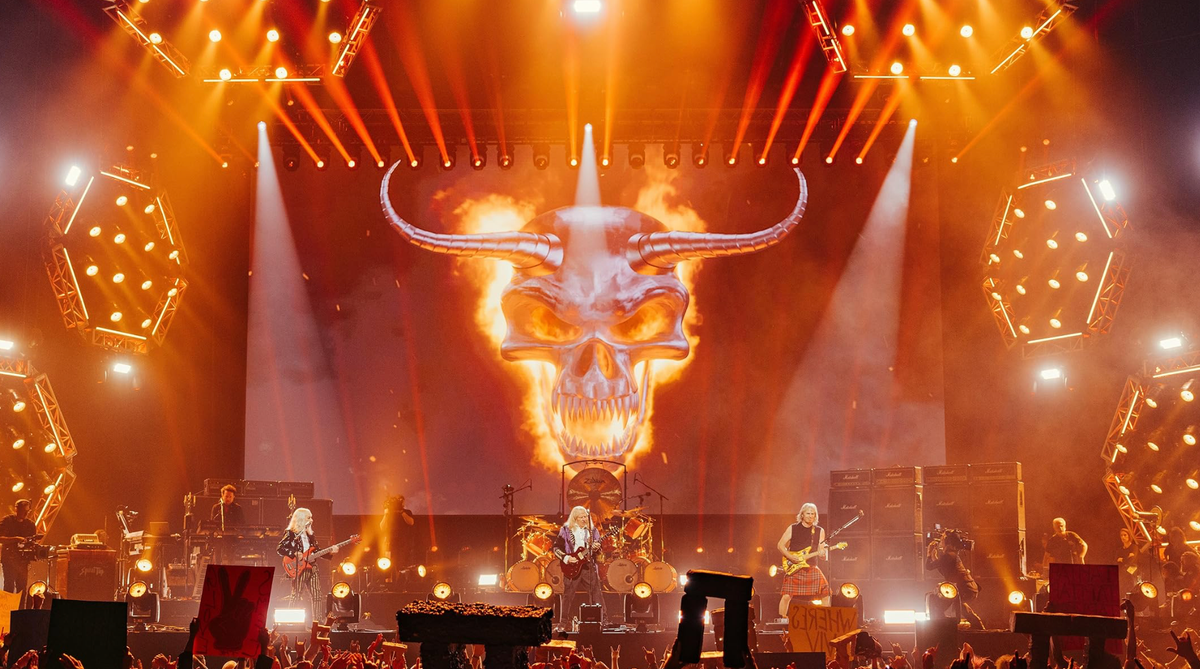Actress and musician Olivia Phoenix takes a look at the return of the legendary mock-rockers in Spinal Tap II: The End Continues.
After four decades, the infamous Spinal Tap turn their amps back up to eleven for Spinal Tap II – The End Continues. These rockers are determined to prove that even the most satirised heavy metal crocodiles can still snap, or at least sag convincingly, for one final encore.
The film reunites director Marty DiBergi (played by real life-director, Rob Reiner) with guitarists Nigel Tufnel (Christopher Guest), David St. Hubbins (Michael McKean), and bassist Derek Smalls (Harry Shearer). For the last fifteen years, they have drifted into bizarre sidelines: Nigel runs a whimsical shop pairing guitars with gourmet cheese, David composes podcast jingles, and Derek opens a museum of glue. But isn’t that the nature of most bands? It is true that only a few bands age gracefully, with many others spinning off into strange careers once the spotlight fades. Remember The Clash’s Terry Chimes, who reinvented himself entirely when he became a chiropractor.
Tap’s reunion is triggered by a contract clause buried in the will of their late manager, Ian Faith. His daughter, Hope Faith, insists they honour his final wish: one last concert, or, to put it better, a legendary concert, one that will solidify their legacy and bring them back again to the top charts. No pressure, eh?
The thing is, time has not mellowed them. Nigel and David remain locked in old feuds, their maturity still seemingly frozen in 1984, with declining health and lack of patience that threaten to sabotage the whole affair. Can a band who is notorious for catastrophic tours, strange drummers’ deaths (that are officially labelled “best left uninvestigated”), and a chronic inability to find the stage, actually pull this off?
Mockumentaries such as these have a lot to live up to, as do sequels, so comparisons to the first film are inevitable. That is exactly why director and co-writer Reiner refrains from calling it a sequel. Instead, he describes it as a chance to check in on the band years later. After all, these are cultural parodists and musicians whose glory days are long behind them, and part of the comedy this time around lies in simply finding out what they have been up to.
Reiner needed a reason for their return, and inspiration struck while watching a famous episode of Stranger Things, where Kate Bush’s decades-old hit suddenly surged into the charts. So, he thought, what if Spinal Tap went viral on TikTok? With that spark, the mockumentary gained a reason to return, and the band stumbled back into the spotlight, this time aided by their famous friends Elton John and Paul McCartney. Other artists like Garth Brooks, Questlove and Trisha Yearwood, and many more, make appearances too. And, a little miracle to top it off: someone finally fills the most dangerous role in rock history: the drummer. Hooray! Once again, you see, a woman saves the day.
The film is tight, with an efficient editing process led by Bob Joice. It was shot using two digital cameras, where Rob would record about two takes of roughly 30 minutes each. Once again improvised, and later cut down to around two minutes, as Rob himself says, “we don’t want to bore the audience”. This editing expertise mimics the approach used in 1984, when the team shot around four hours of 16mm footage, also filled with improvised scenes, which Reiner trimmed to emphasise the strongest comedy and punchy bits. What a hardcore fan might notice, though, is that in Tap II, our stars are a little more tired, worn out by life’s demands. In their youth, they carried that familiar rock and roll ego, convinced of their own coolness. But now the added years bring a weary authenticity.
This is a comedy that will hit home for those who have seen the original. Newcomers from this generation get to check out a continuation of something that stamped its mark on ’80s culture, which had rock and rollers such as Ozzy Osbourne and The Edge fooled by their ability to authentically portray real rock music.
The budget for This Is Spinal Tap II was around 22.6 million dollars, likely due to the inclusion of heavyweight guest stars who ensure some memorable moments. By contrast, the 1984 original was made for under 2 million and faced far greater production setbacks, as most studios were reluctant to take a chance on something untested. It was only thanks to producer Karen Murphy’s willingness to back the project that This Is Spinal Tap came to life, a film that went on to make history and inspire later projects such as The Office.
On the subject of money, the last few decades saw the band’s real life battle with the industry, which proved just as absurd as fiction. Despite Spinal Tap’s success, Harry Shearer, who plays bassist Smalls, revealed in 2016 that Universal had paid the band just 98 dollars each in royalties in over 18 years. That propelled him to launch a 125 million dollar lawsuit against Universal, and he was soon joined by his bandmates, who together asked for 400 million.
In 2020, they final won their legal battle - settled for an undisclosed sum - and while Universal kept temporary distribution rights, the creators secured eventual full ownership. This is definitely a fittingly defiant final chord to their decades-long fight for artistic control and a victory against a system that still exploits artists.
This is a sequel that will do your heart good. Sure, this is likely the last time you will see these crocodiles dominating the stage. But Spinal Tap II: The End Continues is worth the watch for the tunes alone. They still hit hard.
Spinal Tap II: The End Continues is available to stream online now.

